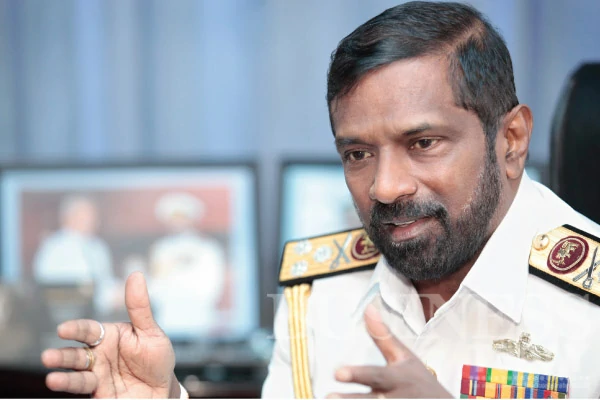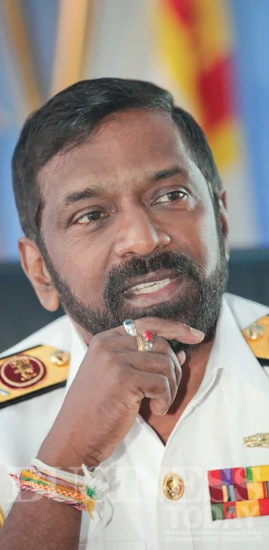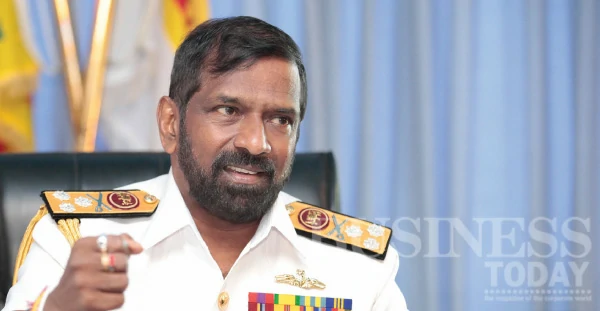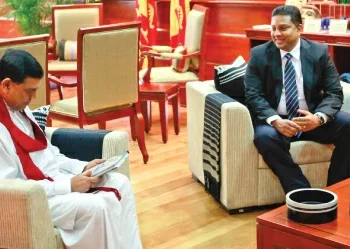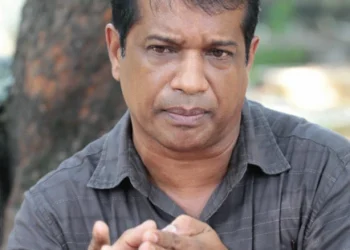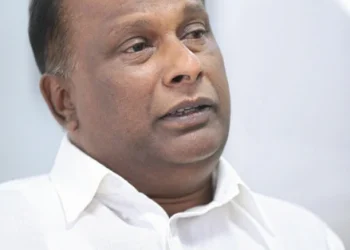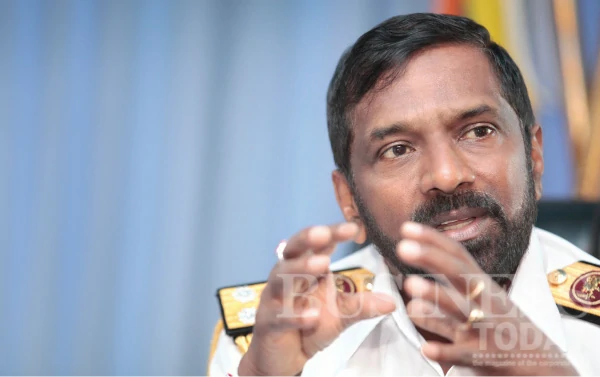
As an island nation with the expansive ocean surrounding it, Sri Lanka is yet to tap the great resource that is at our fingertips. With Sri Lanka envisioning to be a Maritime Hub as it surges forward as the Wonder of Asia, the Sri Lanka Navy plays a key role in making this a reality. Many steps have already been taken in this regard, and while the Sri Lanka Navy (SLN) remains the guardians of the sea, the part they play in the economy as well as diplomacy of the country is significant. Vice Admiral Jayanath Colombage, Commander of the Sri Lanka Navy speaks about the multidimensional aspects of the SLN as well as the importance of harnessing the great ocean.
Words Udeshi Amarasinghe Photographs Menaka Aravinda and Mahesh Bandara
Can you tell us about the role of the Sri Lanka Navy (SLN) in the present environment?
The Sri Lanka Navy was actually formed in 1950. With the passage of time and especially with the 30-year long conflict, the Sri Lanka Navy evolved to become a high- tech modern navy. We played a key role in eliminating terrorism in Sri Lanka. We contributed very effectively especially by dismantling the LTTE’s supply chains. As you know for any organisation to sustain they need an efficient logistics system. There was a time when the LTTE totally depended on the sea, to transport their weapons, cadre, medicine, fuel and even rations. We really focused our attention on cutting off their logistics, which we achieved by destroying the four remaining LTTE floating warehouses, far away from Sri Lanka in international water very close to Australia. We believe that this was a turning point in the conflict.
Having Contributed Effectively To The End Of The 30-Year Long Conflict In May 2009, We Had To Adapt Ourselves Very Quickly To Perform Duties During A Post-Conflict Period. With Peace, The Livelihood Of The People In The North And East Had To Be Restarted.
We also played a vital role in the humanitarian rescue operation where we had to rescue the people trapped under LTTE guns. We had a huge task of transporting these people to safe locations and then direct them to the IDP centres, which the government established.
Having contributed effectively to the end of the 30-year long conflict in May 2009, we had to adapt ourselves very quickly to perform duties during a post conflict period. With peace, the livelihood of the people in the North and East had to be restarted. Sri Lanka being an island nation with the ocean around us, fishing is a key livelihood activity for coastal communities. The North and Eastern provinces are called Maritime Provinces because they are bordering the ocean and even the North-Western province up to a certain limit is a Maritime Province. We had to motivate the fishermen in these regions to go back to sea, as due to the war most of the facilities had been destroyed, the fishermen lost their boats, fishing gear and way of life. We stepped in and provided the fishermen with the required facilities and equipment and gave them the confidence to return to their livelihood.
During the war we had a system to monitor fishing as the LTTE was exploiting everything at sea; whether it was an innocent fishing boat or an Indian fishing trawler, they exploited it. Therefore, we had to control fishing, by restricting the distance, time, the number of people in each boat as well as the horse power of the out-board motors. Today there are no restrictions for fishermen. We want the fishermen to enjoy the benefits of freedom, the dividends of peace. But with that came certain other issues because not all are genuine. There are certain elements that would exploit any situation. For example large-scale human trafficking was taking place, which we had to curtail. This is called irregular migration by sea. These people were initially trying to go to Europe and Canada, but they later shifted towards Australia. We had to take steps to prevent this because it is an issue of law and order for our country. Anyone can leave or enter the country from legal exit/entry points such as our ports and airports with valid travel documents. But these people were not going like that. They were exploiting the relaxation of the fishing restrictions.
We had to deploy our vessels as well as engage in intelligence gathering and surveillance to resolve this problem. We have been successful so far where we have captured 83 boats and detained 4,400 would-be illegal migrants to Australia. Furthermore, we have also rescued migrants from Bangladesh and Myanmar. They were on the way to Australia and their boat had developed engine trouble and were drifting at sea. We rescued them and brought them to Sri Lanka.
Another dimension, of course, is while we are continuously carrying out surveillance at sea, we have another issue-poaching by fishermen from Tamil Nadu, India. Furthermore, these fishermen are using illegal fishing gear as well as illegal fishing methods. Therefore we have to be on guard to prevent this from happening because there will be a negative impact on our fisheries. Our marine life will not be able to reproduce and their habitats will be destroyed. This affects the future of our marine resources and ecological systems; therefore, the Navy has focused its fullest attention on that.
The SLN is engaged in development work, even in Colombo. This is a very different role that the SLN is performing. Can you elaborate on this aspect?
During the conflict our numbers had to be increased because at that time we needed manpower, we needed people to fight and people to maintain peace in the recaptured areas and to ensure that these areas were not captured by the LTTE again. The SLN had to guard the coastline of our country. We had many activities at sea. Together with the Army, Air Force and the Police, the strength of the SLN was also increased. We have a 55,000 strong Navy; for a country of our size, it is a large number.
We Are Gainfully Employing The Additional Personnel That We Have. The Advantage Of Having The Military Engaged In Construction Is That The Cost Is Less, Time Used Is Minimal And The Work Is Of Very Good Quality.
Following the conclusion of the war there was an uncertainty as to whether the military would be downsized and those who had volunteered to defend the country would be asked to leave. This would have demoralised our Armed Forces. Fortunately the President, HE Mahinda Rajapaksa and Secretary of Defence and Urban Development, Mr Gotabaya Rajapaksa did not resort to such actions but instead mobilised them for development work. With the amalgamation of urban development with the Ministry of Defence, our Secretary is also in-charge of urban development, which he undertook voluntarily. As such, the SLN is fully engaged with city development under the Ministry of Defence and Urban Development. The naval personnel too play a key role in this endeavour, where they are engaged in restoring heritage buildings as well as canal systems to their pristine glory. There was a time when Colombo, especially the area near the Parliament in Sri Jayewardenapura, would get flooded with the slightest of rain. No one had really focused on flood mitigation systems in the city before. We started cleaning and dredging canals as well as making them an environmentally-friendly mode of transportation. Travelling by boat in the canal system would lessen the traffic condition in the city.
We are building our headquarters in Akuregoda. The entire defence establishment including the Ministry of Defence, headquarters of the Sri Lanka Army, Navy and Air Force will relocate to a single location in Akuregoda. The construction of this complex is being done entirely by the military. We are gainfully employing the additional personnel that we have. The advantage of having the military engaged in construction is that the cost is less, time used is minimal and the work is of very good quality.
The renovation work of the building housing Central Point, the museum of the Central Bank on Chatham Street was done by the SLN as well as the Wetland Park in Nawala. We are currently engaged in the renovation of the former Auditor General’s building. The SLN also played a role in the development of the area around Diyawanna Oya as well as introducing a boat service so that people can enjoy the beauty of the Parliament.
We have also started a few business ventures such as hotels, resorts and restaurants in scenic locations. To date we have ten such ventures and we have employed Navy personnel for all activities. Through such endeavours they are acquiring additional skills such as masonry, carpentry, plumbing as well as in areas in the hospitality industry. These skills will be useful for them even after they leave the military one-day.
Our Study Revealed That Sri Lanka Has Great Potential In Ports. We Have The Colombo South Harbour, Which Is One Of The Best And Biggest Harbours In The Region. Hambantota Has Great Potential As It Is Very Close To The Busiest Shipping Lane In The World.
The Sri Lanka Navy is also a key partner in making Sri Lanka a Maritime Hub.
The vision of President Mahinda Rajapaksa is for Sri Lanka to emerge as the Wonder of Asia. This is to be achieved through the development of the five hubs, namely Aviation, Knowledge, Maritime, Energy and Commercial. The SLN is focusing on the Maritime Hub. All hubs are inter-connected; for example trade and energy will have a link to the sea. Therefore, out of the five hubs we are mainly focusing on the Maritime Hub. The aim is to take advantage of Sri Lanka’s geographical location as in ancient times where the country was a key point in the silk route.
The SLN is known as the Guardian of the Sea and we are like a fence around the ocean protecting our country. We have done so in the past, reaching the high point with the completion of the conflict and we continue to do so today. In the development of the Maritime Hub, the Secretary to the Ministry of Defence and Urban Development is the Hub Master. As the Commander of the Sri Lanka Navy, I work as the Operational Hub Master under the Secretary. We conducted a study to see what needs to be done to achieve the Maritime Hub. Our study revealed that Sri Lanka has great potential in ports. We have the Colombo South Harbour, which is one of the best and biggest harbours in the region. Hambantota has great potential as it is very close to the busiest shipping lane in the world. Sri Lanka is in the centre of the shipping lanes connecting the East to the West. Therefore, we need to take advantage of this opportunity. Trincomalee Harbour, which is a natural deep-water port, is still unexploited. Building ports is one thing, but there are many other aspects that need to be looked into, such as maritime administration and maritime legislation.
We presented our findings to the President, Secretary of Defence and the Security Council where the Secretary to the Treasury, Foreign Secretary, Secretary to the President and the Service Commanders were present. They took our recommendations very seriously. For the first time in many years, the 2013 Sri Lanka Budget spoke of a shipping economy. President Mahinda Rajapaksa’s vision is result-oriented, he speaks about improving shipping related capabilities in the country and maritime education to produce future seafarers. Maritime education is very important because a seafarer has a greater earning capacity and they will be able to generate greater foreign revenue for the country through employment overseas.
The President is also keen on having a state-of-the-art Ocean University in Sri Lanka. As an island with the ocean around us, Sri Lanka is not yet a maritime nation. The sea is an untapped resource. We are looking at a merchant shipping authority to focus on administration and legislation. There is great hope and potential for Sri Lanka to become a Maritime Hub and we are focusing on achieving this status.
You are also the Chairman of the Ceylon Shipping Corporation.
In our study we found that the Sri Lanka Shipping Corporation was not doing well. It essentially does not have any ships. The Sri Lanka Shipping Corporation was established in the 1970s with the introduction of Merchant Shipping Act. The Corporation performed extremely well during that time. We were a leading shipping company offering worldwide services with an office in London. With containerisation in the early 1980s, Sri Lanka too focused on container and cargo handling. With the market economy, the Sri Lanka Shipping Corporation lost its way. We have now identified the need for a strong Shipping Corporation in Sri Lanka, where it becomes the national flag carrier for the country. We have identified the strength and briefed the President on the same. We need to acquire ships for the Corporation.
In the past the Sri Lanka Shipping Corporation produced good quality seafarers who today hold high positions. There is a huge potential in training seafarers because they can easily secure foreign employment and generate income for the country. If we look at Philippines about five percent of their GDP is from seafarers. Though Sri Lanka is an island nation some of our ships are registered in Mongolia, which is a landlocked country. It is essential that we have an open registry and allow ships to come in and trade. More than 4,000 ships enter Colombo Port every year and Hambantota is located close to the main East-West shipping line where more than 250 ships pass each day. We need to capitalise on these opportunities. The Sri Lanka Shipping Corporation can focus on these areas. There are many commodities coming into Sri Lanka such as coal and crude oil-these are transported by sea. These can be handled by Sri Lanka Shipping Corporation. We want to strengthen the Corporation to its former glory. We have presented our recommendations to the President and he appointed me as the Chairman to structure Sri Lanka Shipping Corporation into a profitable and efficient organisation.
I have 34 years of experience in the SLN. Although I am not a merchant mariner, I know the sea and I have interacted with merchant mariners. I played a key role in developing port security networks as well as training, deploying and planning according to the convention put forward by the International Maritime Organisation. As such, I had much interaction with the seafaring community, and that helped me to do my job.
I am a member of the Nautical Institute and currently the Chairman of the Sri Lankan branch. In recognition of my work, I was made a fellow of the institute and the Annual General Meeting (AGM) of the Nautical Institute, which is usually held in the UK or Ireland was held in Sri Lanka in 2013. It was for the first time in its history that the annual conference was held in Asia. The theme was ‘Maritime Administration, Where At, Where to’. Much knowledge was shared and discussions were held. There were many inputs on maritime administration. I am combining all my experiences and the blessing of the President and the Secretary of Defence to steer the Sri Lanka Shipping Corporation. We are in the process of building two ships at the moment. They are 65,000DWT (Dead Weight Tonnage) each. We are focusing our attention on chartering some ships to transport coal and crude oil.
We have some excellent maritime training institutions in Sri Lanka but we lack sea training, as we have to depend on external ships for training. There is renewed hope in the shipping community because they all know that the President, Secretary of Defence, Secretary to the Treasury and the BOI are keen on developing this sector. We have a project minister dedicated to this sector, Minister Rohitha Abeygunawardane. Further, they look at my appointment to the Corporation as a positive sign and a step in the right direction. Many foreign companies have expressed their interest in working with the Corporation and we are also looking at public-private partnerships and bilateral cooperations especially in the region, with Maldives, India and Pakistan. We have a business plan and we will restructure the Sri Lanka Shipping Corporation accordingly. We have a well-educated staff who are versed in maritime matters. They will be assigned duties to match their skills. They are very positive.
Another aspect that we are looking at is the introduction of appropriate regulations to govern the industry. That is important not only locally, but internationally as well. To be a Maritime Hub, we have to have our own legislation.
Currently From The Ships Entering Colombo Harbour Not Even Ten Percent Acquire Bunkering From Colombo Because They Always Compare Prices. Unless We Are Competitive The Shippers Will Not Buy Bunkering.
In the Budget it was mentioned that a Maritime Authority would be setup. This would not be a single person but an authority. They will be vested with coordinating powers on all matters maritime. That is a step in the right direction towards achieving Maritime Hub status.
What is the feedback from the private sector?
The private sector is very keen. Currently from the ships entering Colombo Harbour not even ten percent acquire bunkering from Colombo because they always compare prices. Unless we are competitive, the shippers will not buy bunkering. There are 11 government and private sector companies engaged in bunkering, but they have an issue of importing oil because they lack storage. In Sri Lanka we have few organisations; the Ceylon Association of Ships Agents, Company of Master Mariners, Nautical Institute and Lanka Association of Ship Operators. We all work as one team as there is renewed hope. Sri Lanka is situated in the best location in the Indian Ocean. The Indian Ocean will be the key ocean in the 21st Century. We are equidistance from the Western land, that is Madagascar and the Eastern land extending all the way to the Indonesian archipelago and Australia, we are at the centre. Therefore, we have great potential. The private sector believes in the vision of the President. He is always inquiring about the progress in the shipping sector. As a person who was the Minister of Fisheries and hailing from the South, the President understands the importance of tapping the oceanic resources. Furthermore, from the five hubs, achieving the Maritime Hub status is the most workable because we are focusing on an existing resource. It is a matter of harnessing the potential that is around us.
The leisure industry at sea is an untapped resource. Our tourism usually stops at the beach. Whale and Dolphin watching as well as diving is still limited to a few. The leisure sector is another area where the private sector can contribute.
I chair a meeting once in every two months to discuss the progress on the Maritime Hub and I report the outcome to the President and Secretary of Defence. The Secretary to the Treasury also has discussions with ship owners, ship agents, freight forwarders, importers and exporters. We have a very conducive environment to resurrect the shipping related industry and to be a Maritime Hub.
The Sri Lanka Navy ensures that our territorial waters are secured but also there is a big role in maintaining relationships with other countries. What can you tell us about this?
The navy in any country is one of the key flag bearers of that country. A Sri Lankan Naval ship is a representative of the country; it flies the flag of the country and all the naval ships of the world’s navies are good ambassadors. The SLN is linked to maritime diplomacy. We are fully focused on developing regional, bilateral and international diplomatic channels through the SLN. We have an annual symposium called the Galle Dialogue. In 2010 when we started, we had only 11 countries, but by 2013 this had increased to 35 countries participating, which included the Chief of the Indian Navy who came in 2013, and the Australian Navy Chief, in 2012. Galle Dialogue is our way of sharing our experience and concerns on maritime matters. We have been able to garner the interest of global players as far away as Australia, New Zealand on one side and America and Canada on the other. They hold the Sri Lanka Navy at a very high esteem.
There is the Indian Ocean Naval Symposium, which is limited to the littoral states of the Indian Ocean and also another with ASEAN countries. We have bilateral discussions, joint exercises and trilateral working arrangements on maritime security. One example is the arrangements we have with Maldives and India to promote maritime security. Sharing information, sharing resources, collaborative methods and joint training, through which we can secure the maritime environment in the region.
I Would Say There Are No Traditional Fishing Rights In Sri Lankan Waters For Anyone Other Than Sri Lankan Fishermen… Our Concern Is Compounded By The Fact That Indian Fishing Vessels Are Engaged In Bottom Trawling, Which Is A Very Destructive Method Of Catching The Fish.
We also have a responsibility to carry out search and rescue operations of a large area in the Indian Ocean. We have responded positively in rescuing a large number of people.
Of course poaching is a bit of a contentious issue between Tamil Nadu and Sri Lanka. Though Tamil Nadu persists that they have traditional fishing rights in Sri Lankan waters, I would say there are no traditional fishing rights in Sri Lankan waters for anyone other than Sri Lankan fishermen. Now even the Central Government of India filed an affidavit in the Chennai High Courts on January 20, 2014 saying that Indian fishermen do not have any fishing rights in Sri Lankan waters, because the international maritime boundary line between the two countries, India and Sri Lanka was determined in 1974 and there was a follow up agreement in 1976. Both countries have to respect this. The fishermen of one country do not have any fishing rights in the waters of another. There are no traditional fishing grounds for anyone in Sri Lankan waters; it is only for Sri Lankan fishermen. Our concern is compounded by the fact that Indian fishing vessels are engaged in bottom trawling, which is a very destructive method of catching the fish. Through this method they scoop the seabed, which destroys the corals and marine habitats. They are essentially destroying the marine ecology.
The SLN will only act as a deterrent, and we are committed because this is the livelihood of our people, the future of our fishermen. If there are no fish in Sri Lankan waters our people will lose their livelihood, earning power and that will have a negative impact on the economy of our country as a whole. We work very closely with the Ministry of Fisheries and Aquatic Resources. Secretary of Defence is very keen on settling this issue. We contribute to the discussion forums held between the two countries as well as in the joint working group.
Final thoughts?
The future of our country lies in the ocean. The Sri Lanka Navy is 64 years old and we have evolved throughout the years. In the 1970s we were focusing on preventing illicit emigration across the Palk Strait, in the 1980’s we were countering smugglers and with the escalation in the conflict we were engaged in fighting maritime terrorism. And if you analyse the world maritime contemporary history there has not been any war at sea other than the 1982 Falkland war where the Royal Navy fought with the Argentinian. But here in the Sri Lankan context, we have experienced the worst form of maritime terrorism. We managed to secure the sea and break the logistic backbone of the LTTE. We are determined to do our duties in the post-conflict period and we have a wealth of experience that we are willing to share with the private sector as well as other countries. We are sharing our hard earned knowledge even with academia, business and corporate sectors in Sri Lanka. We have a social responsibility where our knowledge and experience will be essential for the future.
The SLN will not be expanded but the current strength is ready to react to any situation if the need arises. It can be a natural disaster or a man-made disaster. We are continuing with training, which is important where we are creating professionals who will be contributing to the country for many years to come. We have established a Merchant Marine School in Trincomalee and we hope to train future seafarers at this institution. That is an investment for the future.
Our future lies in the ocean because our land mass is limited but our population is growing. We have right now seven times the land mass at sea called the Exclusive Economic Zone, where the potential is yet unknown. We have to capitalise on the shipping ports, ship building, leisure industry and providing maritime services.
We have the best location in the world and that is why many large countries are focusing their attention on Sri Lanka. Therefore, the SLN has a great responsibility to ensure that our people get the maximum. We are very concerned about the marine environment because it is rich in biodiversity. We have to protect the marine environment. We are committed to do that. We are also engaged in finance generating projects.
We are focusing on improving the welfare aspect of the naval personnel as well as career guidance. We have to empower them with more knowledge as we have to produce officers and sailors who are capable of fulfilling the requirements of the 21st Century.
We work as one team because we are one country, one nation, one people. There is no competition among us because we have to compete with other countries. The government is doing its best by engaging in massive development projects where roads, sea-ports and airports have been developed to provide a conducive environment for the private sector and industries to grow. We have to focus on achieving the vision for the country by combining all possible resources, stakeholders and segments in our society so that we can be the great country that we deserve to be.
